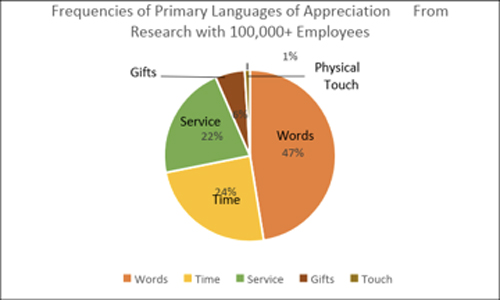Do millennials want to be shown appreciation differently?

The workforce is changing rapidly, with the number of millennial employees expected to surpass baby boomers (individuals in their late 50s and older) by 2019 and they will comprise nearly half of the total working population by 2020. Organizational leaders and HR professionals affirm knowing and understanding your employees is critical in order to have (and keep) an effective workforce, thus, distinguishing and addressing the differences between employees of different age groups is important.
Adjusting to the characteristics and desires of younger employees has been the source of much research. The Gallup Group found that the majority of millennials (55%) are less engaged at work than all other generations and that earning more money is not the primary driving force for them. Additionally, 88% of millennials report they desire a collaborative work-culture (in contrast to a competitive one) and 74% want flexible work schedules. Further, millennials want to have a part in improving the world, and they highly value feedback and acknowledgement, to the extent that they would like feedback every week or immediately, when possible.
They are less motivated by earning than more money than their older coworkers are.
The importance of appreciation in the workplace
Through a series of studies and interviews with one million employees across the world, the Gallup organization found the process of communicating appreciation to employees to be one of the core elements related to increasing employee engagement. Importantly, the level of employee engagement within a workplace has been shown to be highly predictive of numerous positive benefits, including less absenteeism, reduced internal theft by employees, fewer on-the-job accidents, higher customer ratings, lower staff turnover, and greater profitability.
In another global study of over 200,000 employees, the most important factor related to employees enjoying their job was that they felt appreciated.
Unfortunately, however, expressing appreciation is not commonplace. A study by the John Templeton Foundation found that 60% of employees say they either “never” express gratitude at work, or do so perhaps once a year.

Generational differences in desired appreciation?
Given the amount of attention devoted to the unique characteristics of millennials, we began to wonder if younger employees differ in how they like to be shown appreciation from their older colleagues. Therefore, we compared the responses of over 62,000 employees on the Motivating By Appreciation Inventory, comparing the responses of millennial employees with employees who were from older generations.
The question we sought to answer was: Do employees who are millennials have different preferred languages of appreciation than older employees?*
What we discovered
When considering how employees from different age groups prefer to be shown appreciation, two key themes are consistent across millennials and older employees. First, words are still the most frequently desired language of appreciation.
Therefore, communicating through verbal interactions orally and in writing (utilizing texts, emails, and personal notes) are the most effective. But the data confirm an important finding to note: Almost half of all employees (regardless of age group) prefer to be shown appreciation in ways other than words.
Conversely, the use of Tangible Gifts are consistently chosen to be the least preferred way to be shown appreciation across all age groups. Anecdotally, individuals report that if they only receive some tangible reward (gift card, tickets to an event) but never receive help when needed, hear a word of praise, or have someone stop by to see how they are doing – gifts feel very superficial and meaningless.
Frequencies of appreciation languages for millennials
| Millennial
Employees |
Older
Employees |
|
| Words | 46% | 47% |
| Time | 31% | 25% |
| Service | 17% | 23% |
| Gifts | 7% | 5% |
There are differences across age groups, however. For millennials, Quality Time is more frequently desired than Acts of Service, to a significant degree (31% vs. 17% of the respondents). That is, younger employees feel more valued when they spend time with colleagues than they do when someone helps them accomplish a task.
In contrast, older employees are about evenly divided between valuing time with their coworkers and getting practical help from others, while millennials more strongly prefer Quality Time with others.
Additionally, when we examined the specific types of Quality Time younger employees desire, they are more interested in spending time with colleagues and not as much with their supervisor (which is a change from previous generations). This is consistent with other research findings which has found that millennials enjoy working collaboratively with others.
The following specific action steps are indicated by the results of our research:
- Don’t solely use words to show appreciation. Otherwise you will miss the mark with over 50% of your team members.
- Discover how your employees want to be shown appreciation. Don’t use the “one size fits all” approach – you will waste time and energy.
- Make sure employees are okay with public recognition. If not, communicate your appreciation privately.
- Facilitate relational time between team members. Share meals together, have (and allow) some informal “hanging out” time, especially for younger employees.
- Build non-financial motivators into your workplace culture. Talk about how what your company does contributes to making the world a better place to live. Pursue flexibility in work schedules
Since more and more employees are (and will continue to be) millennials, leaders and supervisors need to understand what is important to them and the factors that motivate younger employees to become fully engaged in their work. Clearly, earning more money (by itself) is not the prime motivator for most millennial employees. Conversely, working collaboratively with team members, having a sense of improving the world, having the ability for a flexible work schedule, and wanting frequent feedback are all important factors to this generation of employees.
Despite the fact that words of affirmation is the most commonly preferred language of appreciation in the workplace, focusing upon words alone would leave half of employees feeling unappreciated. Other ways of communicating appreciation (spending quality time, acts of service, a small tangible gift, celebratory actions) need to be utilized, as well. Further, millennials are more likely than their older colleagues to feel appreciated when they are able to hang out with colleagues to celebrate the completion of a milestone rather than spending time with their supervisor.
The one thing that is foundational for successfully conveying appreciation in the workplace is to communicate in the appreciation language that is desired by each individual. Taking your team members through the process of assessing their preferred languages of appreciation and then making an effort to implement these concepts into your workplace culture is critical. This is a small investment that creates a win-win-win situation (for the employee, for the supervisor, and for the company) and results in a more positive workplace!
*To see the original research, go to this link
Tags: appreciation, Management, millenials, millennials, recognitionCategories 5 Languages of Appreciation, Employee engagement, Gratitude, Leadership, Managers
